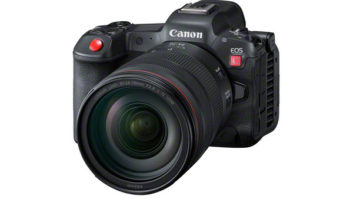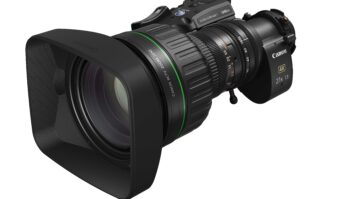Canon has introduced a new, entry-level HD DSLR that will cut the cost of shooting full HD, taking it well below the price of any semi-pro camcorder, writes David Fox.
The new EOS 550D camera will probably be available for under _800, including a kit lens, when it ships on February 24.
It uses a newly developed 18 Megapixel APS-C (22.3×14.9mm) CMOS sensor (more than five times the size of the 2/3-inch sensors commonly found in broadcast cameras), with Canon’s advanced DIGIC 4 14-bit image processor, as used in the larger 7D.
Users can record 1920×1080 at 24, 25 or 30 frames per second, or 720p at 50 or 60fps. As seen with the 7D, the 550D should produce excellent pictures in low light – it can record at ISO settings of 100 – 6400 (expandable to 12800), with noise reduction delivering clean looking images. It also has a 3.5mm stereo microphone socket for an external microphone.
Highlight tone priority can be set independently for movie capture, without changing any still image capture settings. The 550D also has a new Movie Crop function that records with the central 640×480 pixel area of the sensor, giving 7x magnification, however this isn’t available for HD recording (where it would probably have to be 4x or 5x).
From an ergonomic point of view, the smaller size, and lighter weight (530g body) of the 550D, may make it easier to hold than Canon’s existing, larger, HD DSLRs.
For video output, there is a mini HDMI port, but this doesn’t give access to the uncompressed video signal (for recording to an external recorder). Recording, to a SDHC card, uses the .MOV format with H.264 video and Linear PCM audio at 45Mbps (for a maximum duration of 30 minutes or 4GB file size).
There is also a 3-inch 720×480 pixel LCD screen (which has to be used in video mode as the conventional viewfinder can’t be used because the internal mirror is locked up).
Canon has also announced a new EOS Movie plug-in for Final Cut Pro, to enable quicker and easier editing of EOS footage. A free Beta release of the plug-in will be available to download in March. The plug-in will enable the log and transfer of video footage from the EOS 5D Mark II, EOS 7D, EOS-1D Mark IV and the 550D, and convert the recordings to Apple’s high quality ProRes 422 codec at approximately twice the speed of Apple’s standard conversion. Users will also be able to add timecode, reel names and metadata.






